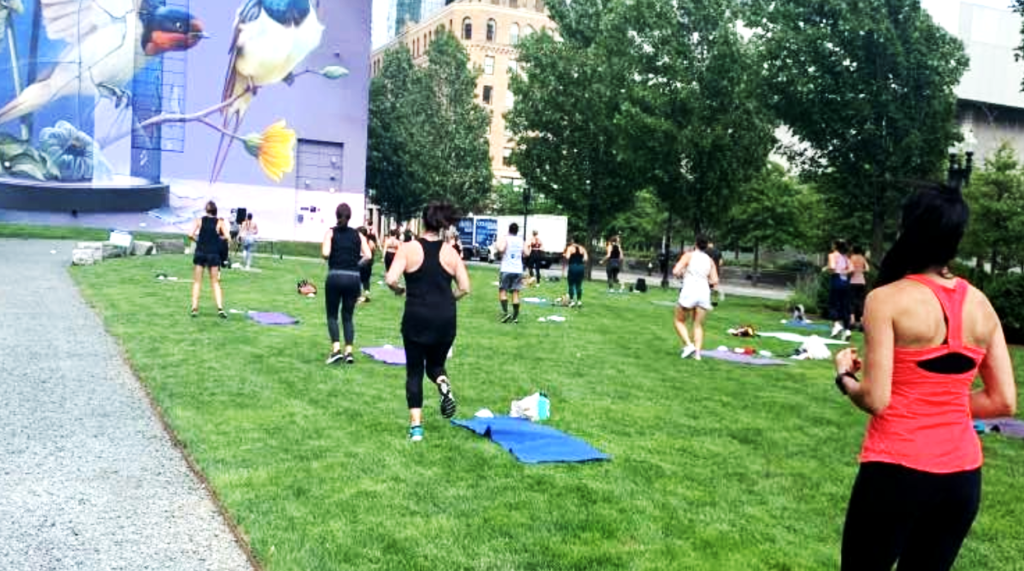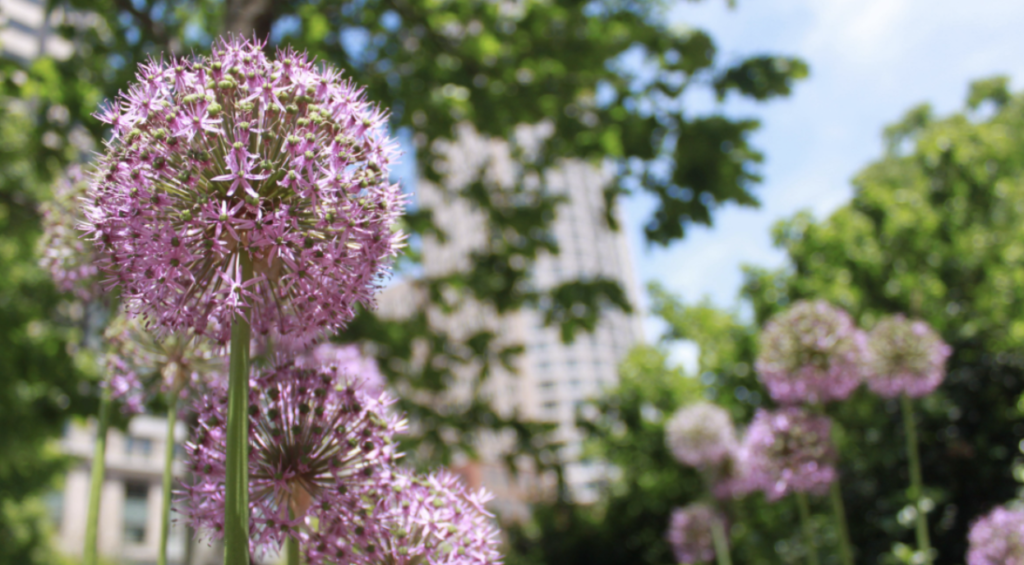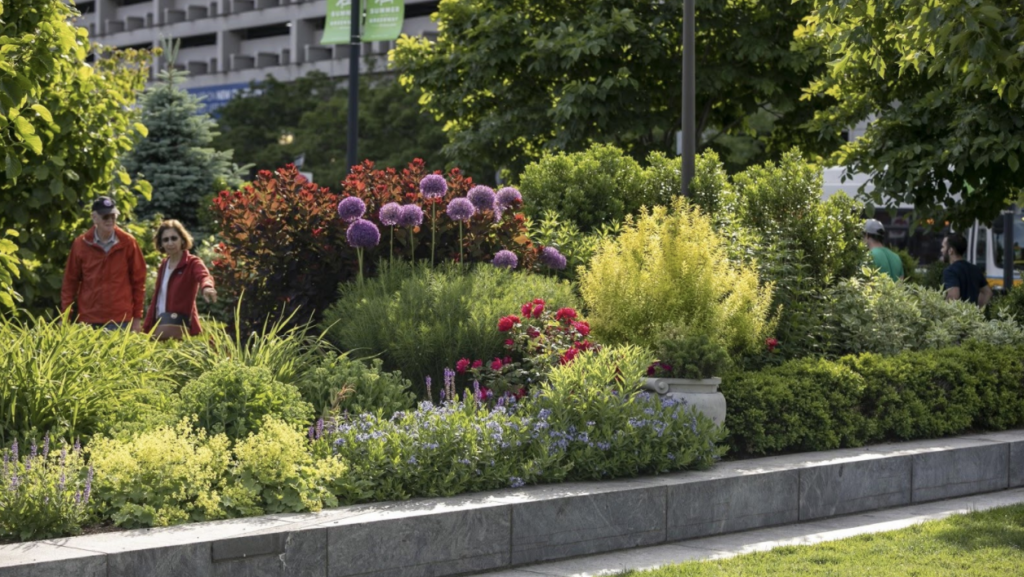Thank you to those that joined our October 22 webinar, diving deeper on the what, why, and how of the Conservancy’s organic practices, especially the brewing and application of compost tea to promote healthy soils.
Greenway Conservancy Director of Programs and Community Engagement Keelin Caldwell moderated a lively conversation engaging perspectives from Conservancy horticultural experts and volunteers. The panel explored the range of Greenway sustainable park care practices, highlighted the role of our talented staff and volunteers in organic maintenance, and provided a behind the scenes look at our innovative Compost Tea operation.
The Conservancy received a number of questions from the community during this virtual event; below is a collection of these questions, with answers from our panelists.
Is there real tea in Compost Tea?
As Tori, the Conservancy’s Ecological Health Care Horticulturist, says in the video, you shouldn’t drink compost tea – and that is because it’s not real tea! The reason it’s called compost “tea” is because it ends up looking like tea (i.e. brown water). No tea leaves or herbs are used in the production of compost tea, and you don’t use boiling water, but rather highly oxygenated water that encourages the growth and reproduction of beneficial soil biology.
How much Compost Tea do you use on The Greenway lawns?
The Conservancy produces around eight thousand gallons of compost tea each year, with three thousand gallons applied to our lawns and five thousand gallons applied to our garden beds. Every lawn on The Greenway gets a compost tea application about three times a year and all garden beds twice per year.
What are the ingredients in the Conservancy’s Compost Tea?
We use the following ingredients in our compost tea: water, oxygen, compost, liquid kelp, liquid humates, fish hydrolysate, and flour. To activate our compost tea, we add in azomite, kelp meal, alfalfa meal, molasses, baby oats, and humic acid.
Is compost high in phosphorus? Can this runoff in soil and pollute water?
High levels of phosphorus can be a side effect of using large amounts of compost. With it being in an organic form and the fact that it is fairly immonbile and stable in our soils it is not something we tend to worry about too much. Also, as we base all of our decisions off of soil tests and the conditions that are present in each area, generally as a rule our phosphorus levels are good and when using Organic fertilizers we use a product without it or very low levels if needed. . In addition, the Conservancy’s compost tea is full of microbes that, when added to the soil in the park, actually mitigate runoff through building of organic matter. Most homeowners should not encounter this problem. That said, it’s another reason that soil tests can be very helpful in understanding the biology in your own yard. High levels of any nutrient can pose a problem for plant health or produce runoff. Runoff happens much more frequently when using synthetic fertilizers because these nutrients are in inorganic forms that are water soluble and can break down quickly.

Where does the Conservancy get their soil tested?
Soil testing for both lawns and planting beds is done on a regular basis to allow us to understand the chemical and biological health of our soils and trends from year to year. We use the University of Massachusetts Soil and Plant Nutrient Testing Laboratory for standard and organic nutrient testing as well as chemical analysis, and Soil Foodweb New York to determine biological health of a selected subset of locations. The lawn samples are drawn in early September, while our bed samples are taken in the first week of October.
What is the average pH of The Greenway lawns?
The average pH of The Greenway lawns ranges from 4.9 to 6.4. In 2019, our average pH across The Greenway lawns was 5.9, based on the most up to date soil testing data. The Conservancy is working towards a goal of increasing our lawn pH towards a 6.2 to 6.5 range so that nutrient availability is optimized for turfgrass.
Has this year’s drought impacted how to care for The Greenway’s lawns?
Having a healthy soil ecosystem means that our lawns have deeper and more robust roots and a better ability to retain and access moisture. Through yearly lawn renovations, monitoring soil health, selecting the right grass seed species and higher mowing heights, our lawns are incredibly resilient.
Throughout the year, the Conservancy relies on natural rainfall amounts supplemented with our irrigation systems, to reach a goal of providing 1” of water a week (). Irrigation for the lawns is scheduled for the early morning hours, and is complete between 6:00a to 6:30a. Lawns are watered for 30 to 60 minutes, twice per week at the beginning of the season, increasing to three times per week in the summer as needed. We continually monitor weather patterns and adjust our irrigation schedules accordingly throughout the year. Our irrigation system is carefully planned to deliver equal amounts of water across the full lawn and is checked on a regular basis for any clogs or leaks.
How does the change in the weather affect the microorganisms’ activities in the soil?
Microorganisms are sensitive to changes in temperature and moisture, and are most active when the soil is between 60 and 80 degrees and contains some moisture. We only brew and apply compost tea in the spring and the fall to optimize the introduction of new soil biology. In periods of extreme weather such as extreme drought or heat, microbes can also go through periods of dormancy. This is why overall soil health is so important to building resilient lawns and garden beds.

With the heavy use and foot traffic on Greenway lawns during summer, how do you deal with soil compaction and avoid disturbance to the living organisms in the soil?
Great question! There are a few ways we address this challenge. First, we aerate our lawns at least twice a year (Spring and Fall) and as needed during the season in heavy use areas. Aerating removes small amounts of soil, creating small holes that stimulate additional root growth and allow for air, water, and nutrients to access the root zone. Second, we carefully plan and monitor events. We are very careful about what infrastructure we allow on lawns and utilize our hardscapes and plazas for high-impact events. We rotate our fitness classes and quickly address or “rest” small lawn areas that might be getting too much use. On our lawns, soil microbes do see some impact from heavy use, especially in fungal populations. This is one of the reasons why we apply Compost Tea to the lawns three times a year, as opposed to our garden beds only twice a year. Overall, by building up lawns that are healthy, with deep roots, and appropriate moisture, nutrients, and ecology, our lawns are resilient and can handle the wear and tear of public life.
Does The Greenway have a special type of lawn? Does the Conservancy use endophytic seed?
The Conservancy primarily uses an athletic mix of grass seed which includes about 70% Kentucky Bluegrass, in 2 or 3 different varieties, and about 30% Perennial Ryegrass, again in 2 or 3 different varieties. We also use a shade mix in a few areas which includes more fescues. This shade mix is about 85% fescues (including Creeping Red, Chewings, and Hard Fescues), about 10% Perennial Ryegrass, and only 5% Kentucky Blue. This year we have also started experimenting with a primarily turf type tall fescue mix in areas that we’ve historically had the most issues with grubs.
Does the Conservancy use neem at all on The Greenway?
The Conservancy does not use neem at all on The Greenway lawns or garden beds.

Does the Conservancy ever use black plastic to reduce weed growth?
We do not use black plastic on The Greenway. Black plastic can be used in areas where there are a lot of weed seeds in the soil and you are starting a new planting; the sun heats the plastic and kills the seeds in the soil. The Conservancy did use sheet mulch when establishing a meadow area several years ago, to allow the plugs and seeds we planted to get established. After removing much of the undesirable vegetation from the area by hand, we then used a biodegradable paper (newspaper/cardboard can be used as well) to reduce weed growth.
Can you make Compost Tea at home? What advice do you have for at-home gardeners looking to do something similar?
You definitely can make compost tea at home, though it may be too much equipment for most home gardeners. A good first step is to test any soil you plan to apply your compost tea to and do your research to see if building out a compost tea system is the right fit for you. For example, the Conservancy’s Compost Tea Program uses 50 gallon drums, aquarium pumps, and PVC piping for our brewing tanks.
If I am treating soil with chemicals, do the chemicals leach into the plants that grow?
It depends what you mean by chemicals. Like all living things, plants rely on nutrients to grow and any type of fertilizer (organic or synthetic) will include the chemical nutrients that plants most need to thrive. Chemical fertilizers tend to be heavy in salts and harsher to the soil biology; while they provide and release the nutrients that plants need, the way they are packaged means they can harm the ecosystem of the soil or more easily runoff into water sources. If you are talking about herbicides like RoundUp, that is a more complicated issue and depends a lot on what substance is used and how it is applied. If you are treating your soil with anything, a good first step is to start with a soil test. If the chemical is capable of leaching, there is concern not only around your plants but also your ground water. In addition, if you are growing your own produce and are worried about edible plants, a soil test is always a good place to start as some chemicals that may be in the soil, like lead, can potentially leach into crops.
I tried organic fertilizer and my lawn only had weeds and crabgrass so I went back to conventional methods. How can I better address this?
Transitioning to an organic approach can take time, since the high salt content in most synthetic fertilizers means that the soil microorganisms are often struggling to survive. Weeds are “opportunists” and It is natural for them to move into lawns, especially as the soil health is recovering and in the heat of the summer. Hand pulling, while time consuming, is very effective with common weeds and crabgrass, many of which have wide spreading foliage coming from a single root to try to shade out grass. Lawns flourish and grow best in the spring and the fall so focus on pulling weeds during those times and adding sod or grass seed to fill in any bare areas. tWe ourselves focus on hand pulling as needed, which was more necessary in the first couple years, but coupled with other practices like raising the mowing height to 3-½ -4”, not bagging clippings and allowing them to get mulched back into the lawn and overseeding twice a year will help create a thick, dense turf which will naturally eliminate opportunities for weeds to get a hold. It may also be helpful to slowly transition your lawn so that you can focus on one area at a time, letting it get stronger and more resilient which should cut down on future weeding.

If an organization is considering starting an organic program for their open space, what type of infrastructure and space requirements would you recommend they plan for?
The Conservancy’s organic care and compost tea brewing program is run out of the lower level of the North Bennet Street School building in the North End, and is not by any means a large space. When thinking about building an organic program, thinking about costs, soil testing, analysis, product research, and dedicated labor needs are just some of the things to consider. Start with reviewing the inventory and budget that your organization has and go from there.
What kind of things does the Conservancy do in the winter on The Greenway lawns and gardens?
The Conservancy Horticulture staff is hard at work over the winter, planning and preparing for the next year. Lawn renovations (including aerating, seeding, and top dressing) are done in October and November and we do minimal bed cleanup and cutbacks to prepare for winter from October to December. In November we also winterize our irrigation system, plant spring bulbs, and apply anti-dessicant to select evergreens. From December to February, we focus on winter pruning of our woody plants and monitoring for any weather or critter damage. We also take this time to create planting plans, order plants and supplies, make presentations to garden clubs and other groups, and get all set for the following year. Starting in March, we are back out cleaning up beds in preparation for spring growth.
Do you have critter problems on The Greenway and, if so, how does the Conservancy manage that?
We have several critters that can cause plant damage, such as rats. We contract with a wildlife management company that does selective trapping and removal. We also try to plant plants that seem to not be the rabbits favored food source in areas where the pressure is higher. Our staff works closely with these companies, relaying information to them as they encounter problems out in the park.



